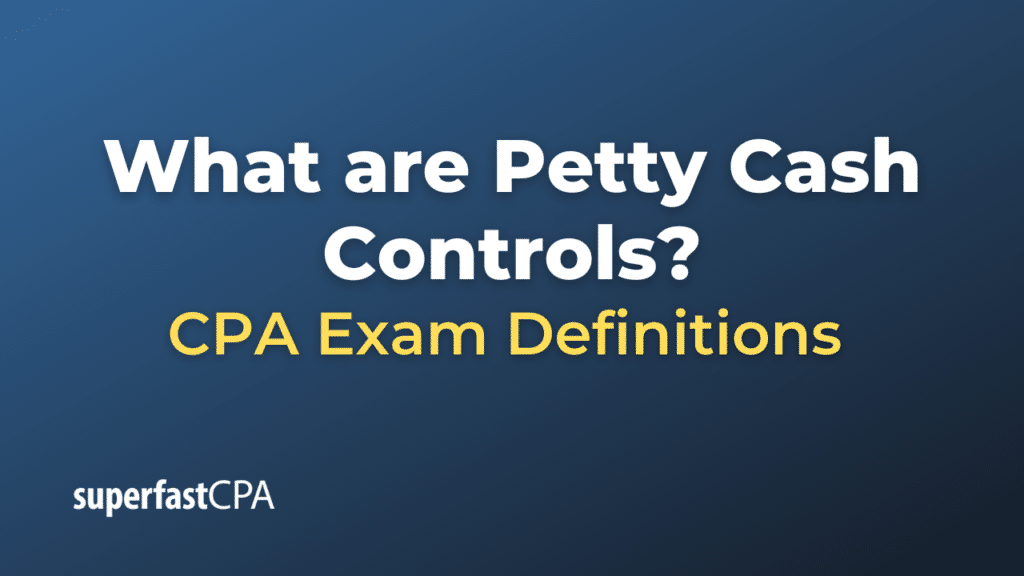Petty Cash Controls
Petty cash controls are guidelines or procedures implemented by a company to manage the disbursement and reimbursement of petty cash, or small amounts of cash kept on hand for minor expenses. They help prevent misuse, theft, and errors in petty cash transactions.
Key petty cash controls typically include:
- Establishing a Petty Cash Custodian: One person, usually referred to as the custodian, is responsible for managing the petty cash fund. This person is accountable for the disbursement, documentation, and replenishment of the petty cash.
- Limiting the Amount of Petty Cash: The amount of cash kept in the petty cash fund should be kept to a minimum to reduce risk. This amount will vary depending on the needs of the business.
- Requiring Receipts for all Transactions: Every time money is disbursed from the petty cash, a receipt should be obtained and kept as a record. If a receipt isn’t available, a petty cash voucher detailing the transaction should be filled out and kept.
- Reconciliation: Regularly (often monthly), the petty cash fund should be reconciled. This involves adding up the remaining cash and the total of the receipts and petty cash vouchers to ensure they total the original amount of petty cash.
- Secure Storage: The petty cash fund should be stored in a secure location, such as a lockable cash box, to protect it from theft.
- Periodic Audits: Periodic surprise counts and audits of the petty cash fund by an independent person can help ensure compliance with petty cash procedures and identify any issues.
- Replenishing the Fund: When replenishing the petty cash fund, a check should be written for the exact amount of the petty cash expenditures, not the original petty cash fund amount. This helps ensure that all petty cash transactions are recorded properly in the company’s financial system.
By implementing these controls, a company can help ensure that its petty cash is managed effectively and that all transactions are properly recorded and accounted for.
Example of Petty Cash Controls
Let’s illustrate the concept of petty cash controls with an example.
Let’s say ABC Company has set a petty cash fund of $100, with John as the custodian. They implement the following control measures:
- Establishing a Petty Cash Custodian: John is responsible for handling all petty cash transactions. He disburses cash for small expenditures, collects receipts, and records each transaction in a petty cash log.
- Limiting the Amount of Petty Cash: ABC Company has determined that $100 is sufficient to cover small, incidental expenses for a given period. This limit minimizes the potential loss in case of theft or fraud.
- Requiring Receipts for all Transactions: Every time John disburses petty cash, he asks for a receipt from the employee who received the money. For example, if Sarah needs $15 for a taxi fare, she gives John the taxi receipt when she returns. If a receipt isn’t available, John fills out a petty cash voucher noting the details of the expenditure.
- Reconciliation: At the end of each month, John adds up all the receipts and vouchers and compares the total to the amount of cash left in the petty cash box. If the original $100 is not accounted for, John looks for errors or missing receipts.
- Secure Storage: John keeps the petty cash in a locked drawer at his desk to prevent unauthorized access.
- Periodic Audits: Unannounced, the company’s internal auditor conducts a surprise count of the petty cash fund to ensure all procedures are being followed and to identify any discrepancies.
- Replenishing the Fund: When the petty cash fund runs low, John requests a check to refill the fund. He uses the total of the receipts and vouchers to determine the amount needed to bring the fund back to $100. The request is approved by his supervisor and recorded in the company’s financial records.
By implementing these controls, ABC Company is able to effectively manage their petty cash, ensuring it is used appropriately and all transactions are accurately recorded.














